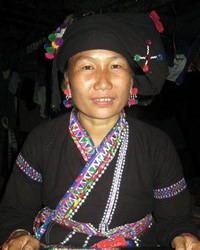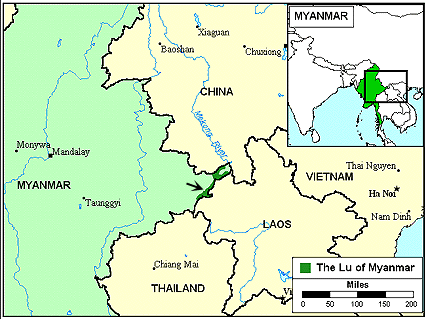The Tai Lue live along the high hillsides of the easternmost border of Myanmar. They primarily inhabit the Kengtung district and the region where the Shweli River crosses into China. Their language, Lu, belongs to the southwestern group of Tai languages.
China is the original homeland of the Tai Lue; however many have migrated south due to pressure by the Chinese. A large number fled to Burma, Thailand and Laos during World War II. At that time, a communist regime was established in China, bringing an end to the Tai Lue kingdom.
Myanmar has experienced an array of coups, wars and rebellions. Today, the Burmese military maintains forcible control over the ethnic groups, such as the Tai Lue, who want to have equal importance in the government and in commerce.
Tai Lue men traditionally dress in blue coats; dark blue bell trousers with bands of red, yellow or white; and large white turbans. The women wear light blue embroidered jackets that are adorned with small pieces of silver. They also wear red or scarlet skirts and turbans.
Most of the Tai Lue are farmers living in river valleys. There, they grow wet rice for consumption and sale. They still use primitive, wooden equipment drawn by buffalo. The women's specialties include weaving and embroidery. Some Tai Lue work as merchants, buying and selling goods.
Tai Lue villages are located either on raised ground surrounded by rice fields, or on high ground on either side of a road or pathway. Their houses are set on tall posts. They are built with floors of split bamboo, short walls and thatched roofs.
Each Tai Lue village is headed by a chief, whose task includes choosing the right place to sow rice. Rather than a strict form of social control, there is evidence that witchcraft is used to keep the people oppressed.
Homes contain ancestral shrines that are used during marriage ceremonies and in the control of sexual behavior. Premarital sexual relations seem to be accepted among the Tai Lu. Once a couple is married, their living arrangements are decided according to which household most needs the services of the couple.
The majority of the Tai Lue practice ethnic religions. Theravada Buddhism is often mixed with folk animism. They believe that non-human objects have spirits, and that people have multiple souls. They also believe that there are territorial spirits, which are identified with different levels of society. In addition, they practice ancestor worship (praying to deceased ancestors for guidance). They live in fear of their gods and constantly strive to appease them with religious chants, rituals, and sacrifices.
The Tai Lue put great emphasis on reincarnation, believing that if they live a good life they will be reborn into a higher social order. If they are wicked, however, they will be reborn as degraded animals.
The Tai Lue have been tremendously affected by the fighting and bloodshed of the past. They need healing and new spiritual hope. They also need the Lord's protection from violence and destruction.
Ask the Holy Spirit to soften the hearts of the Tai Lue towards Jesus Christ.
Ask God to raise up long-term workers to live among the Tai Lue.
Pray that Tai Lue believers will be bold witnesses for Christ and make disciples of others.
Ask the Holy Spirit to open the hearts of Myanmar's governmental leaders to the gospel.
Pray that Christian radio and television broadcasts will become widely available in their language.
Ask the Lord to raise up strong local Christian fellowships that expand to other fellowships among the Tai Lue.
Scripture Prayers for the Tai Lue in Myanmar (Burma).
https://en.wikipedia.org/wiki/Tai_Lue_people
https://mychiangmaitour.com/tai_lu_people/
| Profile Source: Joshua Project |












